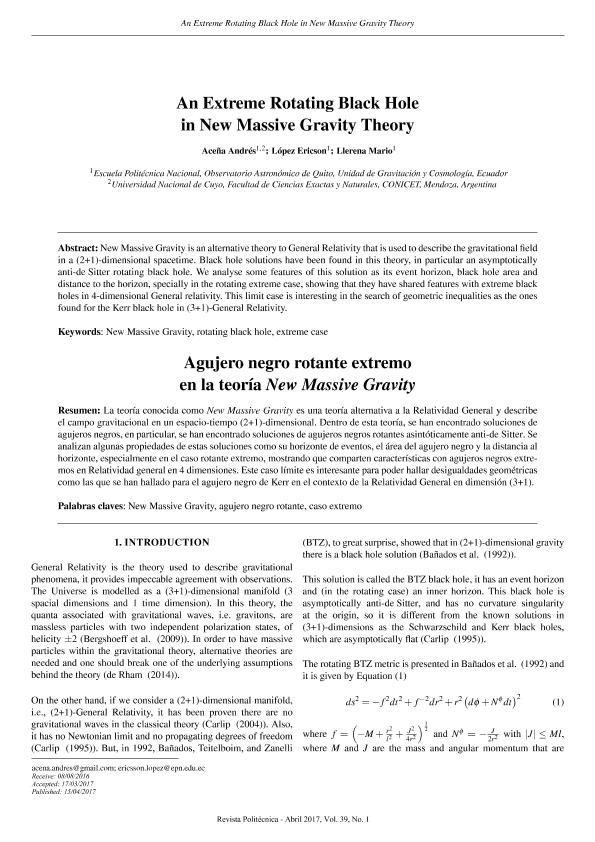Mostrar el registro sencillo del ítem
dc.contributor.author
Aceña, Andrés Esteban

dc.contributor.author
López, Ericson
dc.contributor.author
Llerena, Mario
dc.date.available
2019-02-11T16:51:52Z
dc.date.issued
2017-04
dc.identifier.citation
Aceña, Andrés Esteban; López, Ericson; Llerena, Mario; An extreme rotating black hole in New Massive Gravity Theory; Escuela Politécnica Nacional; Revista Politécnica; 39; 1; 4-2017; 67-76
dc.identifier.issn
1390-0129
dc.identifier.uri
http://hdl.handle.net/11336/69841
dc.description.abstract
New Massive Gravity is an alternative theory to General Relativity that is used to describe the gravitational field in a (2+1)-dimensional spacetime. Black hole solutions have been found in this theory, in particular an asymptotically anti-de Sitter rotating black hole. We analyse some features of this solution as its event horizon, black hole area and distance to the horizon, specially in the rotating extreme case, showing that they have shared features with extreme black holes in 4-dimensional General relativity. This limit case is interesting in the search of geometric inequalities as the ones found for the Kerr black hole in (3+1)-General Relativity.
dc.description.abstract
La teoría conocida como New Massive Gravity es una teoría alternativa a la Relatividad General y describe el campo gravitacional en un espacio-tiempo (2+1)-dimensional. Dentro de esta teoría, se han encontrado soluciones de agujeros negros, en particular, se han encontrado soluciones de agujeros negros rotantes asintóticamente anti-de Sitter. Se analizan algunas propiedades de estas soluciones como su horizonte de eventos, el área del agujero negro y la distancia al horizonte, especialmente en el caso rotante extremo, mostrando que comparten características con agujeros negros extremos en Relatividad general en 4 dimensiones. Este caso límite es interesante para poder hallar desigualdades geométricas como las que se han hallado para el agujero negro de Kerr en el contexto de la Relatividad General en dimensión (3+1).
dc.format
application/pdf
dc.language.iso
eng
dc.publisher
Escuela Politécnica Nacional
dc.rights
info:eu-repo/semantics/openAccess
dc.rights.uri
https://creativecommons.org/licenses/by-nc-sa/2.5/ar/
dc.subject
New Massive Gravity
dc.subject
Rotating Black Hole
dc.subject
Extreme Case
dc.subject.classification
Astronomía

dc.subject.classification
Ciencias Físicas

dc.subject.classification
CIENCIAS NATURALES Y EXACTAS

dc.title
An extreme rotating black hole in New Massive Gravity Theory
dc.title
Agujero negro rotante extremo en la teoría New Massive Gravity
dc.type
info:eu-repo/semantics/article
dc.type
info:ar-repo/semantics/artículo
dc.type
info:eu-repo/semantics/publishedVersion
dc.date.updated
2018-12-19T14:40:16Z
dc.journal.volume
39
dc.journal.number
1
dc.journal.pagination
67-76
dc.journal.pais
Ecuador

dc.journal.ciudad
Quito
dc.description.fil
Fil: Aceña, Andrés Esteban. Universidad Nacional de Cuyo. Facultad de Ciencias Exactas y Naturales; Argentina. Observatorio Astronómico de Quito; Ecuador. Consejo Nacional de Investigaciones Científicas y Técnicas. Centro Científico Tecnológico Conicet - Mendoza; Argentina
dc.description.fil
Fil: López, Ericson. Observatorio Astronómico de Quito; Ecuador
dc.description.fil
Fil: Llerena, Mario. Observatorio Astronómico de Quito; Ecuador
dc.journal.title
Revista Politécnica
dc.relation.alternativeid
info:eu-repo/semantics/altIdentifier/url/http://revistapolitecnica.epn.edu.ec/images/revista/volumen39/tomo1/807.pdf
Archivos asociados
